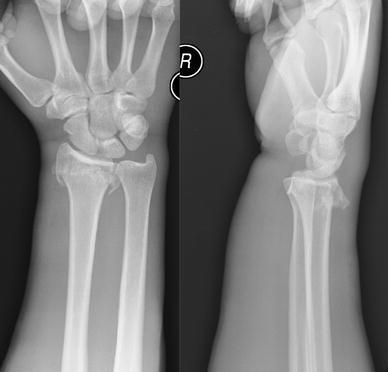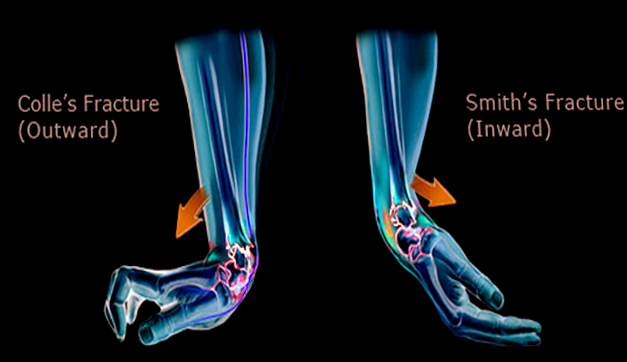[1]
Shah HM, Chung KC. Robert William Smith: his life and his contributions to medicine. The Journal of hand surgery. 2008 Jul-Aug:33(6):948-51. doi: 10.1016/j.jhsa.2007.12.020. Epub
[PubMed PMID: 18656770]
[2]
Omokawa S, Iida A, Fujitani R, Onishi T, Tanaka Y. Radiographic Predictors of DRUJ Instability with Distal Radius Fractures. Journal of wrist surgery. 2014 Feb:3(1):2-6. doi: 10.1055/s-0034-1365825. Epub
[PubMed PMID: 24533238]
[3]
MILLS TJ. Smith's fracture and anterior marginal fracture of radius. British medical journal. 1957 Sep 14:2(5045):603-5
[PubMed PMID: 13460329]
[4]
Matsuura Y, Rokkaku T, Kuniyoshi K, Takahashi K, Suzuki T, Kanazuka A, Akasaka T, Hirosawa N, Iwase M, Yamazaki A, Orita S, Ohtori S. Smith's fracture generally occurs after falling on the palm of the hand. Journal of orthopaedic research : official publication of the Orthopaedic Research Society. 2017 Nov:35(11):2435-2441. doi: 10.1002/jor.23556. Epub 2017 Apr 7
[PubMed PMID: 28262985]
[5]
Chung KC, Spilson SV. The frequency and epidemiology of hand and forearm fractures in the United States. The Journal of hand surgery. 2001 Sep:26(5):908-15
[PubMed PMID: 11561245]
[6]
ALFFRAM PA, BAUER GC. Epidemiology of fractures of the forearm. A biomechanical investigation of bone strength. The Journal of bone and joint surgery. American volume. 1962 Jan:44-A():105-14
[PubMed PMID: 14036674]
[7]
Owen RA, Melton LJ 3rd, Johnson KA, Ilstrup DM, Riggs BL. Incidence of Colles' fracture in a North American community. American journal of public health. 1982 Jun:72(6):605-7
[PubMed PMID: 7072880]
[8]
Vannabouathong C, Hussain N, Guerra-Farfan E, Bhandari M. Interventions for Distal Radius Fractures: A Network Meta-analysis of Randomized Trials. The Journal of the American Academy of Orthopaedic Surgeons. 2019 Jul 1:27(13):e596-e605. doi: 10.5435/JAAOS-D-18-00424. Epub
[PubMed PMID: 31232797]
Level 1 (high-level) evidence
[9]
Lawson GM, Hajducka C, McQueen MM. Sports fractures of the distal radius--epidemiology and outcome. Injury. 1995 Jan:26(1):33-6
[PubMed PMID: 7868207]
[10]
Singer BR, McLauchlan GJ, Robinson CM, Christie J. Epidemiology of fractures in 15,000 adults: the influence of age and gender. The Journal of bone and joint surgery. British volume. 1998 Mar:80(2):243-8
[PubMed PMID: 9546453]
[11]
Hung LK, Wu HT, Leung PC, Qin L. Low BMD is a risk factor for low-energy Colles' fractures in women before and after menopause. Clinical orthopaedics and related research. 2005 Jun:(435):219-25
[PubMed PMID: 15930942]
Level 2 (mid-level) evidence
[12]
Viberg B, Tofte S, Rønnegaard AB, Jensen SS, Karimi D, Gundtoft PH. Changes in the incidence and treatment of distal radius fractures in adults - a 22-year nationwide register study of 276,145 fractures. Injury. 2023 Jul:54(7):110802. doi: 10.1016/j.injury.2023.05.033. Epub 2023 May 10
[PubMed PMID: 37211473]
[13]
Duckworth AD, Mitchell SE, Molyneux SG, White TO, Court-Brown CM, McQueen MM. Acute compartment syndrome of the forearm. The Journal of bone and joint surgery. American volume. 2012 May 16:94(10):e63. doi: 10.2106/JBJS.K.00837. Epub
[PubMed PMID: 22617929]
[14]
McQueen MM, Gaston P, Court-Brown CM. Acute compartment syndrome. Who is at risk? The Journal of bone and joint surgery. British volume. 2000 Mar:82(2):200-3
[PubMed PMID: 10755426]
[15]
Ford DJ, Ali MS. Acute carpal tunnel syndrome. Complications of delayed decompression. The Journal of bone and joint surgery. British volume. 1986 Nov:68(5):758-9
[PubMed PMID: 3782239]
[16]
McKay SD, MacDermid JC, Roth JH, Richards RS. Assessment of complications of distal radius fractures and development of a complication checklist. The Journal of hand surgery. 2001 Sep:26(5):916-22
[PubMed PMID: 11561246]
[17]
Dóczi J, Springer G, Renner A, Martsa B. Occult distal radial fractures. Journal of hand surgery (Edinburgh, Scotland). 1995 Oct:20(5):614-7
[PubMed PMID: 8543866]
[18]
Knirk JL, Jupiter JB. Intra-articular fractures of the distal end of the radius in young adults. The Journal of bone and joint surgery. American volume. 1986 Jun:68(5):647-59
[PubMed PMID: 3722221]
[19]
Schneppendahl J, Windolf J, Kaufmann RA. Distal radius fractures: current concepts. The Journal of hand surgery. 2012 Aug:37(8):1718-25. doi: 10.1016/j.jhsa.2012.06.001. Epub 2012 Jul 3
[PubMed PMID: 22763062]
[20]
Jupiter JB, Fernandez DL, Toh CL, Fellman T, Ring D. Operative treatment of volar intra-articular fractures of the distal end of the radius. The Journal of bone and joint surgery. American volume. 1996 Dec:78(12):1817-28
[PubMed PMID: 8986658]
[21]
Mauck BM, Swigler CW. Evidence-Based Review of Distal Radius Fractures. The Orthopedic clinics of North America. 2018 Apr:49(2):211-222. doi: 10.1016/j.ocl.2017.12.001. Epub
[PubMed PMID: 29499822]
[22]
Bong MR, Egol KA, Leibman M, Koval KJ. A comparison of immediate postreduction splinting constructs for controlling initial displacement of fractures of the distal radius: a prospective randomized study of long-arm versus short-arm splinting. The Journal of hand surgery. 2006 May-Jun:31(5):766-70
[PubMed PMID: 16713840]
Level 1 (high-level) evidence
[23]
Lichtman DM, Bindra RR, Boyer MI, Putnam MD, Ring D, Slutsky DJ, Taras JS, Watters WC 3rd, Goldberg MJ, Keith M, Turkelson CM, Wies JL, Haralson RH 3rd, Boyer KM, Hitchcock K, Raymond L. Treatment of distal radius fractures. The Journal of the American Academy of Orthopaedic Surgeons. 2010 Mar:18(3):180-9
[PubMed PMID: 20190108]
[24]
Hoffer AJ, St George SA, Banaszek DK, Roffey DM, Broekhuyse HM, Potter JM. If at first you don't succeed, should you try again? The efficacy of repeated closed reductions of distal radius fractures. Archives of orthopaedic and trauma surgery. 2023 Aug:143(8):5095-5103. doi: 10.1007/s00402-023-04904-z. Epub 2023 May 13
[PubMed PMID: 37178164]
[25]
Elbardesy H, Yousaf MI, Reidy D, Ansari MI, Harty J. Distal radial fractures in adults: 4 versus 6 weeks of cast immobilisation after closed reduction, a randomised controlled trial. European journal of orthopaedic surgery & traumatology : orthopedie traumatologie. 2023 Dec:33(8):3469-3474. doi: 10.1007/s00590-023-03574-2. Epub 2023 May 16
[PubMed PMID: 37191887]
Level 1 (high-level) evidence
[26]
Glickel SZ, Catalano LW, Raia FJ, Barron OA, Grabow R, Chia B. Long-term outcomes of closed reduction and percutaneous pinning for the treatment of distal radius fractures. The Journal of hand surgery. 2008 Dec:33(10):1700-5. doi: 10.1016/j.jhsa.2008.08.002. Epub
[PubMed PMID: 19084166]
[27]
Bindra RR. Biomechanics and biology of external fixation of distal radius fractures. Hand clinics. 2005 Aug:21(3):363-73
[PubMed PMID: 16039448]
[28]
Slutsky DJ. External fixation of distal radius fractures. The Journal of hand surgery. 2007 Dec:32(10):1624-37
[PubMed PMID: 18070654]
[29]
Tang JB. Distal radius fracture: diagnosis, treatment, and controversies. Clinics in plastic surgery. 2014 Jul:41(3):481-99. doi: 10.1016/j.cps.2014.04.001. Epub
[PubMed PMID: 24996466]
[30]
Orbay JL, Touhami A. Current concepts in volar fixed-angle fixation of unstable distal radius fractures. Clinical orthopaedics and related research. 2006 Apr:445():58-67
[PubMed PMID: 16505728]
[31]
Downing ND, Karantana A. A revolution in the management of fractures of the distal radius? The Journal of bone and joint surgery. British volume. 2008 Oct:90(10):1271-5. doi: 10.1302/0301-620X.90B10.21293. Epub
[PubMed PMID: 18827233]
[32]
Ring D, Jupiter JB, Brennwald J, Büchler U, Hastings H 2nd. Prospective multicenter trial of a plate for dorsal fixation of distal radius fractures. The Journal of hand surgery. 1997 Sep:22(5):777-84
[PubMed PMID: 9330133]
Level 1 (high-level) evidence
[33]
Rothman A, Samineni AV, Sing DC, Zhang JY, Stein AB. Carpal Tunnel Release Performed during Distal Radius Fracture Surgery. Journal of wrist surgery. 2023 Jun:12(3):211-217. doi: 10.1055/s-0042-1756501. Epub 2022 Nov 9
[PubMed PMID: 37223388]
[34]
Velmurugesan PS, Nagashree V, Devendra A, Dheenadhayalan J, Rajasekaran S. Should ulnar styloid be fixed following fixation of a distal radius fracture?(). Injury. 2023 Jul:54(7):110768. doi: 10.1016/j.injury.2023.04.055. Epub 2023 May 2
[PubMed PMID: 37210301]
[35]
Szymanski JA, Reeves RA, Taqi M, Carter KR. Barton Fracture. StatPearls. 2023 Jan:():
[PubMed PMID: 29763081]
Level 2 (mid-level) evidence
[36]
Lozano-Calderón SA, Souer S, Mudgal C, Jupiter JB, Ring D. Wrist mobilization following volar plate fixation of fractures of the distal part of the radius. The Journal of bone and joint surgery. American volume. 2008 Jun:90(6):1297-304. doi: 10.2106/JBJS.G.01368. Epub
[PubMed PMID: 18519324]
[37]
Nesbitt KS, Failla JM, Les C. Assessment of instability factors in adult distal radius fractures. The Journal of hand surgery. 2004 Nov:29(6):1128-38
[PubMed PMID: 15576227]
[38]
Mackenney PJ, McQueen MM, Elton R. Prediction of instability in distal radial fractures. The Journal of bone and joint surgery. American volume. 2006 Sep:88(9):1944-51
[PubMed PMID: 16951109]
[39]
Evans BT, Jupiter JB. Best Approaches in Distal Radius Fracture Malunions. Current reviews in musculoskeletal medicine. 2019 Jun:12(2):198-203. doi: 10.1007/s12178-019-09540-y. Epub
[PubMed PMID: 30847731]
[41]
Franz T. Entrapment of Extensor Pollicis Longus Tendon after Volar Plating of a Smith Type Pediatric Distal Forearm Fracture. The journal of hand surgery Asian-Pacific volume. 2016 Jun:21(2):253-6. doi: 10.1142/S2424835516720085. Epub
[PubMed PMID: 27454642]
[42]
Mansour AA 3rd, Watson JT, Martus JE. Displaced dorsal metaphyseal cortex associated with delayed extensor pollicis longus tendon entrapment in a pediatric Smith's fracture. Journal of surgical orthopaedic advances. 2013 Summer:22(2):173-5
[PubMed PMID: 23628574]
Level 3 (low-level) evidence
[43]
Murakami Y, Todani K. Traumatic entrapment of the extensor pollicis longus tendon in Smith's fracture of the radius-case report. The Journal of hand surgery. 1981 May:6(3):238-40
[PubMed PMID: 7240677]
Level 3 (low-level) evidence
[44]
Bonatz E, Kramer TD, Masear VR. Rupture of the extensor pollicis longus tendon. American journal of orthopedics (Belle Mead, N.J.). 1996 Feb:25(2):118-22
[PubMed PMID: 8640381]
[45]
Roth KM, Blazar PE, Earp BE, Han R, Leung A. Incidence of extensor pollicis longus tendon rupture after nondisplaced distal radius fractures. The Journal of hand surgery. 2012 May:37(5):942-7. doi: 10.1016/j.jhsa.2012.02.006. Epub 2012 Mar 29
[PubMed PMID: 22463927]
[46]
Carroll TJ, Caraet B, Madsen N, Wilbur D. Development of de Quervain Tenosynovitis After Distal Radius Fracture. Hand (New York, N.Y.). 2023 May 28:():15589447231174042. doi: 10.1177/15589447231174042. Epub 2023 May 28
[PubMed PMID: 37246426]
[47]
Li Z, Smith BP, Tuohy C, Smith TL, Andrew Koman L. Complex regional pain syndrome after hand surgery. Hand clinics. 2010 May:26(2):281-9. doi: 10.1016/j.hcl.2009.11.001. Epub
[PubMed PMID: 20494753]
[48]
Lorente A, Mariscal G, Lorente R. Incidence and risk factors for complex regional pain syndrome in radius fractures: meta-analysis. Archives of orthopaedic and trauma surgery. 2023 Sep:143(9):5687-5699. doi: 10.1007/s00402-023-04909-8. Epub 2023 May 20
[PubMed PMID: 37209231]
Level 1 (high-level) evidence
[49]
Christensen OM, Christiansen TG, Krasheninnikoff M, Hansen FF. Length of immobilisation after fractures of the distal radius. International orthopaedics. 1995:19(1):26-9
[PubMed PMID: 7768655]
[50]
Luo P, Lou J, Yang S. Pain Management during Rehabilitation after Distal Radius Fracture Stabilized with Volar Locking Plate: A Prospective Cohort Study. BioMed research international. 2018:2018():5786089. doi: 10.1155/2018/5786089. Epub 2018 Nov 5
[PubMed PMID: 30519581]


